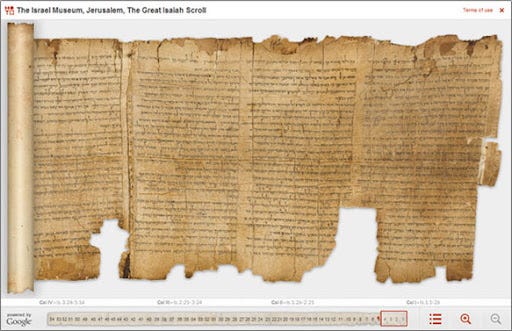Over the past twelve weeks, I have walked through the progress of our world…from the Big Bang and the rise of DNA to the complexities of human consciousness and love. Hopefully, you noticed that I followed a chain of logic throughout these articles…in all cases making conclusions solely based on evidence. For some areas, we don’t have enough evidence or enough comprehension of the subject matter to make many conclusions. That’s okay. Any scientist worth his salt will admit when he/she doesn’t have enough data. And any Christian will admit that we aren’t capable of understanding God’s ways.
Three thousand years ago, the ancients didn’t have any of the science that we understand today. Yet the ancient Hebrews (unlike every other culture) came up with remarkably accurate decriptions of the origins of the universe. As humankind developed better Science, we have confirmed that the ancient Hebrews were “on the right track”. We still don’t have enough scientific understanding to know how humans are different than animals, but given enough time, we will probably isolate the distinctions there as well.
At this point, I have beat the Science horse to death. So let’s saddle up on History. Looking at astronomical models, historical sources, and archaeological evidence, the next set of articles will examine the Bible with a critical eye. Remember that in Science, we can’t really “prove” anything to be certain (see the full article on this topic), and the same is true in History. We can’t prove that the United States bombed Hiroshima…it could be an elaborate hoax, except that it brought a sudden end to the war and we can see the lingering effects in the politics of Asia, in the radioactive decay in the soil, and in cancer patients. Historical evidence places a conclusion beyond a reasonable doubt. So, in History we can build a case with evidence, just as we do in Science.
Let’s start with a look at the Bible as a document. The 66 books in the Bible are written by more than 40 different authors, over a period of 1,500 years. To be precise, we need to look at the Bible as 66 different documents and ask ourselves whether each book is historically accurate.
Historians routinely weigh the value of historical records (their historicity) by looking at various copies, comparing each copy to make sure that their material accurately reflects the original work. If various ancient manuscripts match up, then we can be sure about the content of the original manuscript.
We don’t have any of the original manuscripts of the Bible, written or dictated by fishermen, shepherds, a tax collector, a physician, and others. That’s pretty normal for the times. Similarly, we don’t have the original manuscript of Homer’s Iliad and Odyssey, or Julius Caesar’s Gallic War. These are the best examples of contemporary records that are well established as ancient texts. Homer gave a historical account with a great deal of poetic license, and Caesar wrote his history as a form of propaganda, so both have their biases.
There are 643 manuscripts for The Iliad, and ten manuscripts for Caesar’s Gallic War.[1] Similarly, the Roman historian Tacitus is often used, but only two manuscripts of his Annals of Imperial Rome exist. And 12 copies of Josephus’ work The Jewish War exist today. But each book in the Bible has thousands of copies, far more than these sources.[2]
We’ve looked closely at Isaiah (from the Old Testament) and Matthew[3], which is an eyewitness account from one of Jesus’ followers. These two books compare very favorably with Homer, Caesar, Plato, Josephus, and others…with thousands of copies that match each other extremely well.[4]
Some historians put a numerical value on the ‘purity’ of the text based on the variations in different manuscripts. In this way, Matthew scores much higher than Homer or any other ancient manuscript. In theory, the various copies are identical because the scribes doing the hand-copying would have treated a Biblical text very carefully. Maybe they aren’t so careful when they’re copying text that they don’t consider sacred..
To explore this idea, I looked at the Quran as well: The Quran was translated into at least 7 dialects of Arabic right away (within 30-40 years of being written), and the translation changed the meanings of many words.[5] (Note that Arabs might take exception to this…in their words, the Quran was revealed in seven Ahruf (letters) to the seven Arab tribes at the same time). There is some doubt today about the precise meaning in some passages…in Hafs version Q.3:146 the words “And many a Prophet fought alongside large groups of men” are written in the alBazzi version: “And many a Prophet was killed alongside large groups of men.” That’s a major difference that was lost in translation.
Presumably, Arabic scribes would have been just as careful as the New Testament scribes, but they were dealing with translations to different dialects. To be fair, we could say that our English translation of the Bible has similar variations in meaning to the various versions of the Quran, but at least all Bible translations come from a uniform language (either Hebrew or Greek).
There’s another major difference between the Bible and other religious texts such as the Quran or the Book of Mormon. In other religions, the text was written by a single individual. But the Bible is a self-consistent document that was written by 40 people or more, over a long period of time. The prophecies and their fulfillment are covered by different authors but they retain a consistency that is remarkable. This, in itself, is a reason to take the Bible very seriously.
All in all, the Greek and Hebrew Bible is a unique record of the past—far more widespread than any other document, but with absolutely no change to the meaning of the original text. Further, recent archaeological discoveries (like the 1947 Dead Sea Scrolls) bolster the Bible as a consistent text that is unchanged through history.
Looking at the works of the Bible in this context, we can see that it’s actually the most valuable document in ancient history because of the huge number of original manuscripts, consistency between many authors, and the astonishing lack of differences between various manuscripts.
Over the next few weeks, I’ll look at specific Bible stories to analyze whether history or archaeology can confirm their historical accuracy. Stay tuned.
[1] https://www.revivalandreformation.org/resources/all/why-the-bible-is-historically-reliable
[2] https://ics.uci.edu/~asuncion/transmission_accuracy.htm
[3] https://greeknewtestament.net/matthew-manuscripts
[4] https://www.thecollegechurch.org/wp-content/uploads/2016/08/HANDOUTS-Is-Scripture-Reliable.pdf





